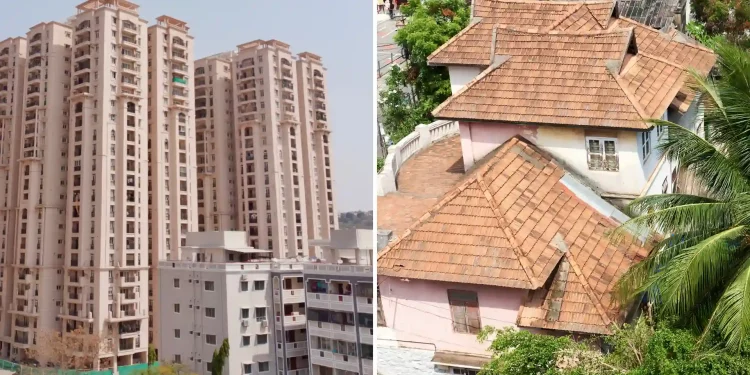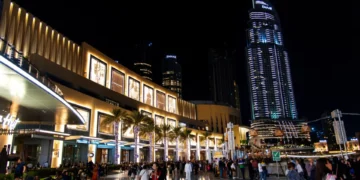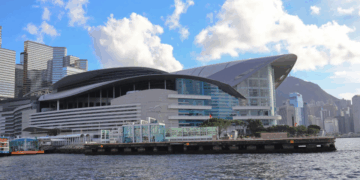Benny Kuriakose recalls the time when his father built the first house in his village in India with a concrete roof in 1968. At the time, it was a status symbol with villagers since concrete was largely used for buildings in Western countries. He remembers that his family was proud of the house, since it had used the ‘modern’ material for the roof.
Reality proved otherwise. Far from being a status symbol, the house became unbearably hot in summer. The concrete roof that he was proud of trapped heat in the day, and radiated it at night. He remembers that neighboring houses with thatched roofs were a lot cooler, since the air trapped between the thatch was a poor conductor of heat.
Benny’s experience was a precursor of the experience that many people in India’s big cities were to face in decades to come. The adoption of modern, standardized international designs for buildings replaced traditional vernacular architecture which had developed over the years to overcome extreme weather conditions across the country.
Modern, box styled structures replaced the cool earthen walls and verandas of houses in Southern states. Today, buildings in places like Bangalore are similar to buildings anywhere in the world, ranging from Chennai to Cincinnati, and Ohio to Orissa.
Kuriakose, now an architect himself, based in Chennai, says that there was no attempt to adapt to local climate or choose the materials available. He says that in most cities, people have blindly copied the Western style of architecture.
The new modern structures have come at a cost to the country. Since April this year, many parts of India have suffered a stifling heatwave, with temperatures ranging from 110 degree Fahrenheit to almost 120 degree in New Delhi. This comes weeks before the official start of summer in the country. The vicious cycle is propagated by the use of air conditioning to combat the heat, which in turn causes more heat to be dispelled, in addition to using more energy.
Using more energy has resulted in multiple blackouts in many Indian cities during the day and night. The additional heat given out by the AC units creates an urban island heat effect. Experts are of the opinion that India’s modern buildings will make it harder for residents to adapt to what could be more common and long-lasting heatwaves.
Recognizing the danger signals, a growing number of environmentalists and sustainability-minded young architects are calling for a return to vernacular architecture. In response, the Indian government in February stated that it would revise urban planning guidelines and train planners to design cities in better ways. Director of Indian Institute for Human Settlements (IIHS), Aromar Revi, said that progress was slow, and that change needs to impact every aspect of city planning. He mentioned that the country was only at the brink of that change cycle.
How traditional architecture lost ground in Indian cities
Traditional Indian architecture began to lose ground in the ‘90s, which is when the country transitioned to a market based economy. Western, globalized styles became the norm as construction boomed, with developers favoring glassy structures with straight lines popular in Western countries. As the push for skyscrapers increased, the amount of land available for gardens or courtyards became scarce.
Developers found that it was easier and faster to build tall structures with steel and concrete instead of using earthen blocks which would not be suitable for high-rise structures.
The consequence of the one-size-fits-all approach was that buildings became less resilient to India’s traditionally high temperatures. Yatin Pandya, and architect based in Ahmedabad said that homes built in the vernacular style required just 20 to 40 kilowatt hours per metre squared of energy for cooling, while most commercial buildings require at least 15 times that amount. While air conditioning units are turned on at night to enable people to sleep, they release more heat into the streets, which could increase the local temperature by 2 degrees Fahrenheit.
He also said that during the day, glassy facades of buildings reflect sunlight directly onto the streets. He was of the opinion that modern architectural styles were causing problems in every direction.
Aromar Revi, director of IIHS, says that even small construction crews responsible for building most of the houses in India, were leaning away from vernacular architecture. Such teams rarely operate under a trained architect or designer, instead relying on what they see for inspiration. In many cases, especially in the cities, international style is often the inspiration for these construction crews.
A climate comeback for vernacular architecture
In what is considered a major step, there is now a shift to revive more region-specific architectural styles, and combine them with the use of modern technologies. In the last decade alone, thousands of architects on the East coast of Tamil Nadu state have promoted the use of earthen walls and roofs. The material can now be used to develop bigger and more complex structures due to the availability of more stable compressed blocks.
In the dry, Northern city of Ahmedabad, Pandya’s company uses a careful orientation and overhanging roofs and walls to shade buildings from heat.
Bangalore-based architect Chitra Vishwanath feels that the industry is correcting course. Vishwanath has built hundreds of buildings, including her own home, using earthen materials. She feels that universities are now teaching students to design and build in climate-specific ways. She adds that younger architects today are more sensitive to climate adaptation. Vishwanath also feels that in another 5 to 10 years, Western style buildings will not be built as much.
She says that wider adoption of climate-sensitive architecture would immensely reduce the amount of energy required to cool buildings. Only 8 percent of Indians had airconditioning in their homes in 2018, and that figure is expected to climb to 40 percent by the year 2038. Unless cleaner cooling technologies can be developed and rolled-out, it would come at a high cost to India’s greenhouse gas emissions.
Increasing the use of traditional materials in India’s sprawling construction sector would also make a dent in the country’s emissions. Vernacular architecture tends to use more natural, locally-sourced substances like earth or timber, rather than concrete and steel, which are created through carbon-intensive industrial processes and transported from thousands of miles away.
Indian researchers in a 2020 paper published in the International Journal of Architecture found that the production of vernacular materials required between 0.11 MJ and 18 MJ of energy per kilogram, compared to 2.6 MJ to 360 MJ per kilogram for modern materials.
Although it would not be feasible to replace all modern materials with vernacular counterparts, even vernacular designs like sloping roofs and detailed window shades are too expensive for people to consider when building their homes. The high cost of land also makes it difficult to construct verandas and courtyards.
Taking into account these challenges, Kuriakose feels that the future of Indian architecture would not be to simply copy what people did 50 years ago, but instead to merge the knowledge system passed down from centuries, with modern technologies available.
Pandya, the Ahmedabad-based architect says that sustainability is not a formula. He feels that like a doctor, architects have to understand the patient, symptoms and conditions, before arriving at a solution.

















